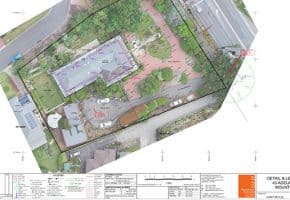Retaining walls are a common source of disputes between neighbours.
The law in South Australia for retaining walls is quite complex. Unlike fences – that are governed by their own legislation – retaining walls are classed as building structures, without their own legislation clearly outlining maintenance and repair obligations.
Retaining walls come under the Encroachments Act 1944 (SA), and a retaining wall that is built on the wrong side of a boundary is an encroachment. This also includes the footings of a retaining wall.
Put simply: as the landowner, you have the responsibility to take reasonable steps to prevent damage or encroachment to the neighbour’s property.
Who pays for a retaining wall?
The most common question when it comes to retaining walls that run along the boundary of two properties is “who is responsible for paying?”
If you wish to build a retaining wall along the boundary between you and your neighbour’s land, determining who pays for it is a case of determining the natural state of the land. The land in its natural state requires no support: it’s only when we alter the state of the land, through excavation or backfill, that it needs support. Anyone can alter the state of their land – subject to the appropriate approval and notices – but with this comes the responsibility to support the adjoining natural land.
As a general rule, each owner is responsible for retaining the portion of earth that they (or the previous landowner) have altered from the natural ground level. This could be fill, placed on top of the natural ground level, or excavation below the natural ground level.
Warning!
Fences and retaining walls are not considered the same under the eyes of the law. In fact, there is a separate SA Fences Act 1975 that we’ve broken down so you understand the differences.
Scenario 1: Retaining walls between properties
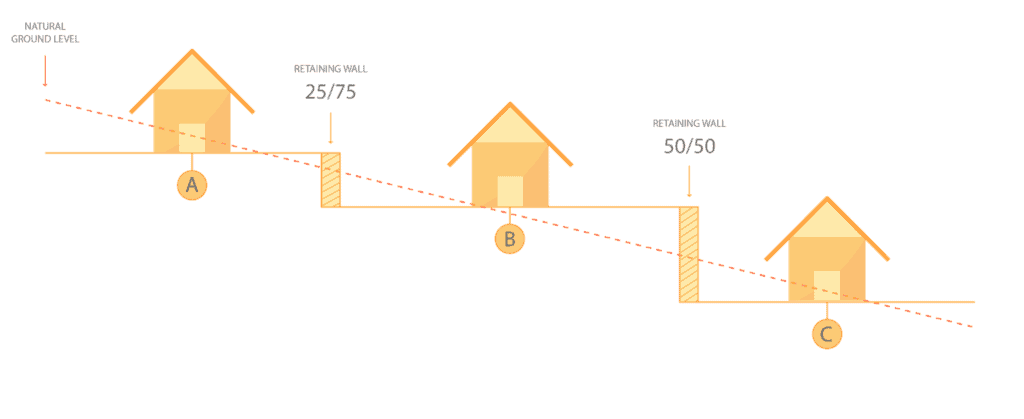
In the image above, the dashed line indicates the natural state of the land, prior to any construction or excavation work. The retaining wall between house A and house B holds up 75% of the land for house B, and 25% of the land for house A. Consequently, house B is responsible for 75% of the costs, and house A is responsible for the remainder.
Likewise, between house B and house C, the retaining wall holds 50% of the land each. This means that each house would be equally responsible for the costs, as they benefit equally from the wall.
Scenario 2: Existing retaining wall and subsequent fill
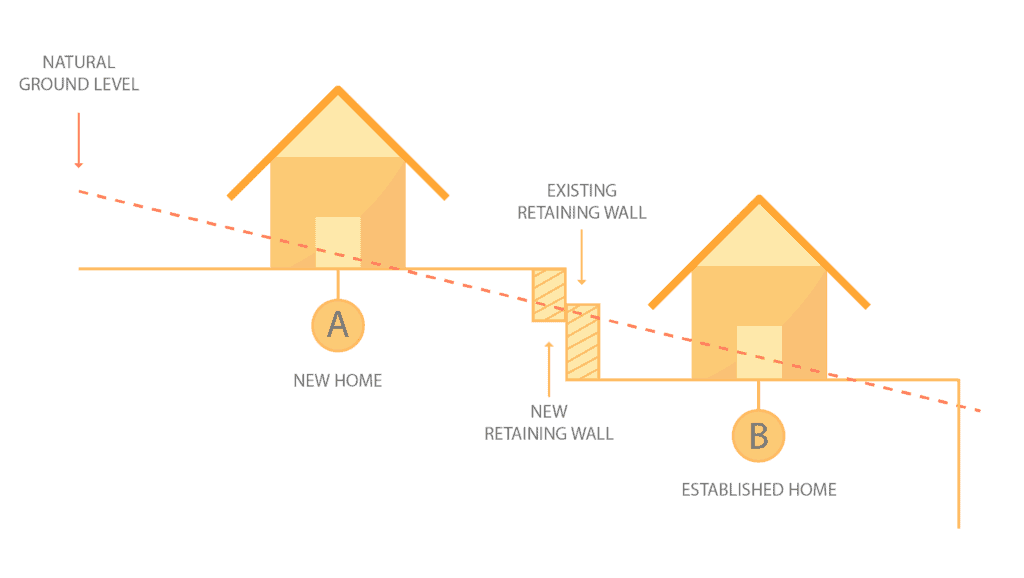
In the image above, house A has proposed to fill – after obtaining the correct approvals and providing notice. As such, house A is responsible for the cost of the retaining wall to hold the fill. House A also has the responsibility to ensure the existing retaining wall above house B is not overloaded with the additional weight of the new fill.
Scenario 3: Existing retaining wall and subsequent excavation
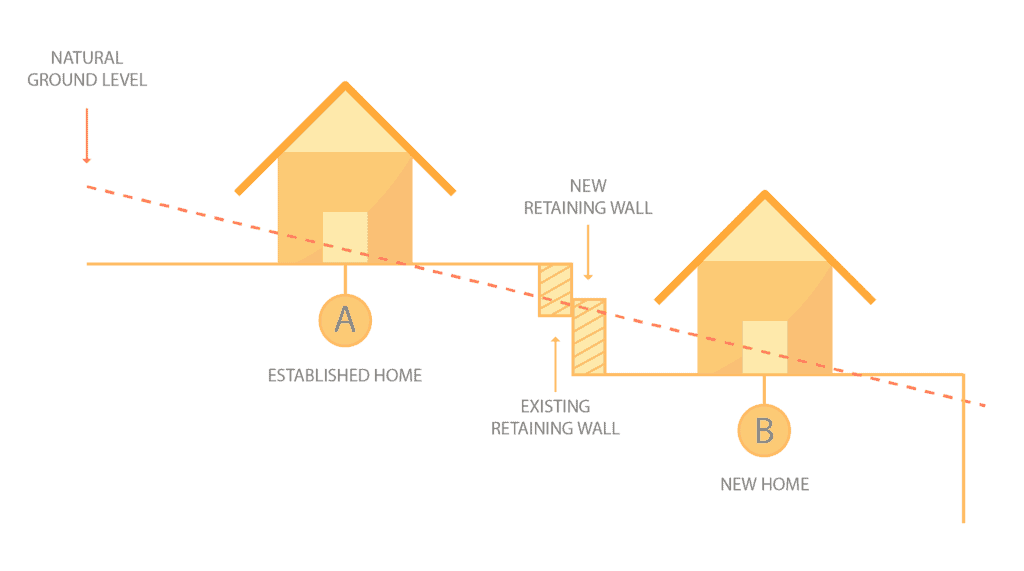
House B has proposed to excavate below house A, where a retaining wall already exists. By excavating this land, house B is responsible for the cost of a retaining wall to support the excavation. Further, house B is also responsible for any costs associated with supporting the existing retaining wall, originally built by house A.
However, under the Development Regulations 2008 (SA), the existing retaining wall (built by house A) should allow for some excavation on the adjoining property (house B). If this was not done, and stabilising is required, house A may be obliged to contribute to the cost of this work.
Scenario 4: The correct location of retaining walls within property boundaries
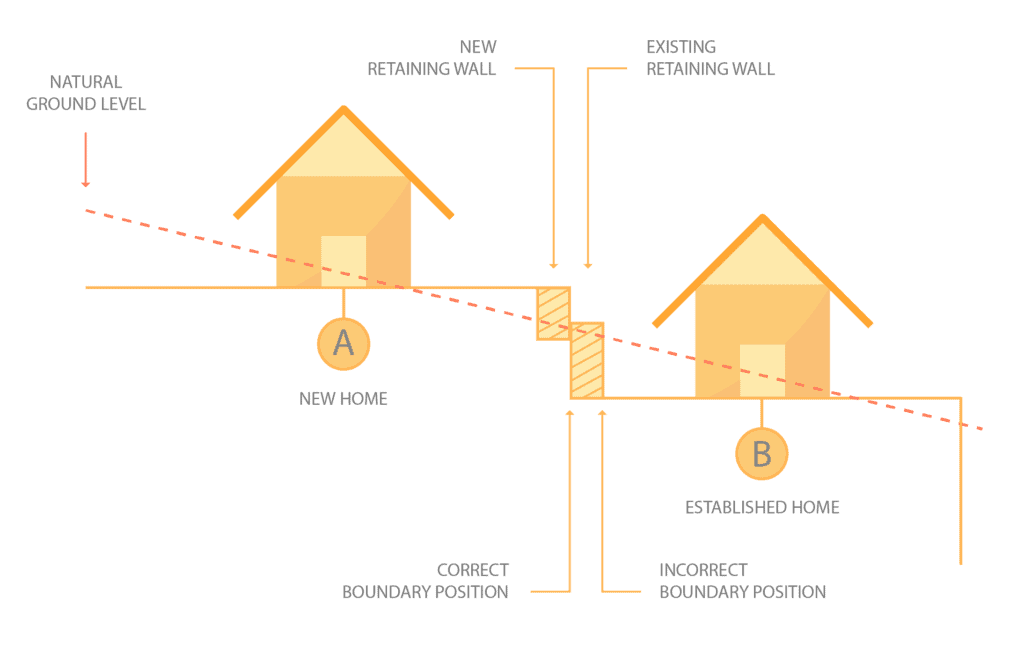
Retaining walls should be located within the boundary of the land which most benefits. In the example above, a new retaining wall, which benefits house A, should be located within house A’s property boundary, not on house B’s property.
Regardless of which side of the boundary the wall has been installed, the landowner receiving the benefit of the wall is responsible for its maintenance or repairs. House B is responsible for the existing retaining wall, as they are receiving the benefit of that wall. Conversely, house A is responsible for maintenance of the new retaining wall, as they most benefit from its installation.
5 Steps to Build a Retaining Wall
Retaining walls can be costly to construct, but even more expensive to repair or modify. Here are five steps to take before building your new retaining wall.
1. Know the natural state of your land
Understand the natural state of your land before any works commence. This will help you to understand who is responsible for the cost of the wall, which landowner it benefits and therefore how or where it should be positioned. A licensed surveyor can identify and mark the boundaries of your land to ensure the wall is placed in the correct location. Remember – retaining walls need to be built entirely within the boundary of one of the properties, not on the boundary.
2. Get the appropriate approvals
Development approval is required if the wall retains a difference in ground level of one metre or more. A retaining wall of one metre or less may still need approval if it is in certain zones – check with your local council whether approval is required. This includes tiered retaining walls totalling less than one metre, fill within 600mm of the boundary (unless it is 200mm or less in height) or for landscaping purposes.
3. Provide adequate notice to your neighbours
If a retaining wall will affect the stability of the neighbour’s land, then the neighbour must be given notice of the proposed work. Even if development approval is not required, you must provide notice of the intention to perform the work and the nature of that work at least 28 days before commencement of the work – for more details, see section 60 of the Development Act 1993 (SA). Failing to provide notice, or failing to carry out any required engineering work after providing notice, can result in fines of up to $10,000.
4. Be aware of any easements
If your retaining wall is going to be built over an SA Water easement, you will need to provide SA Water with a building plan and submit an application. The retaining wall must not impede SA Water’s access to the easement, or have an impact upon any SA Water services.
5. The owner receiving the benefit of the wall is responsible for its maintenance.
As a general rule, a landowner is responsible for retaining the portion of earth that they (or the previous landowner) have altered. This includes fill placed on top of the natural ground level, or excavation below the natural ground level.
Understand the lay of your land
Get in touch with the team at Alexander Symonds and learn how we can help you.
Request a free quoteDiagrams adapted from the SA Law Handbook: https://lawhandbook.sa.gov.au/ch31s04.php

